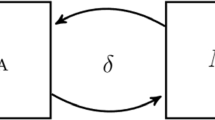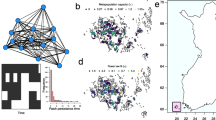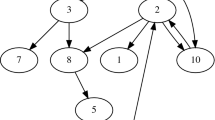Abstract
We present a single-species metapopulation model structured by population size that is discrete in time. The novel formulation of our model allows for explicit incorporation of both the local, in space, dynamics and new details of the dispersal process. To study the impact of between-patch dynamics in the model, we construct various functions to describe density-dependent dispersal, recolonization, and between-patch stochasticity. Due to the complexity of the model, numerical simulations are used to obtain the distribution of the metapopulation. Moreover, we can use our model to predict the proportion of patches occupied, expected patch density, and variance in patch density. Our results provide insight into the influence that each of these processes play in the distribution of the metapopulation. In particular, our findings emphasize the benefit of explicitly modelling these processes. We consider two density-dependent dispersal strategies based upon individuals wanting to form average-sized patches and illustrate the differences in the metapopulation distributions. For recolonization of empty suitable patches, we look at two simplistic redistribution strategies modeled as either a continuous uniform or Laplace distribution. The between-patch stochasticity is modelled using redistribution kernels where we consider both thin-tailed and fat-tailed kernels. We find that the form of density-dependent dispersal has a major influence on the distribution of the metapopulation while recolonization is a key process for metapopulation persistence. In addition, fatter tails for the between-patch stochasticity can decrease the proportion of occupied patches and increase the expected patch density and variance in patch density.








Similar content being viewed by others
References
Anderson BJ, Akçakaya H, Araújo MB, Fordham DA, Martinez-Meyer E, Thuiller W, Brook BW (2009) Dynamics of range margins for metapopulations under climate change. Proceedings of the Royal Society B: Biological Sciences 276(1661):1415–1420
Caswell H, Cohen JE (1991) Disturbance, interspecific interaction and diversity in metapopulations. Biological Journal of the Linnean Society 42(1–2):193–218
Clark JS, Lewis M, Horvath L (2001) Invasion by extremes: population spread with variation in dispersal and reproduction. The American Naturalist 157(5):537–554
Conradt L, Bodsworth EJ, Roper TJ, Thomas CD (2000) Non-random dispersal in the butterfly maniola jurtina: implications for metapopulation models. Proceedings of the Royal Society of London Series B: Biological Sciences 267(1452):1505–1510
Decker RR, Hastings A (2020) Sea-level rise reverses the conditions that promote the spread of ecosystem engineers. Submitted
Dempster JP (1991) Fragmentation, isolation and mobility of insect populations. In: Collins NM, Thomas JA (eds) Conservation of insects in their habitats, London: Academic Press, chap 7, pp 123–145
Doebeli M, Ruxton GD (1997) Evolution of dispersal rates in metapopulation models: branching and cyclic dynamics in phenotype space. Evolution 51(6):1730–1741
Ellner SP, Rees M (2006) Integral projection models for species with complex demography. The American Naturalist 167(3):410–428
Fernández-Chacón A, Genovart M, Pradel R, Tavecchia G, Bertolero A, Piccardo J, Forero MG, Afán I, Muntaner J, Oro D (2013) When to stay, when to disperse and where to go: survival and dispersal patterns in a spatially structured seabird population. Ecography 36(10):1117–1126
Gonzalez-Andujar JL, Perry JN (1993) Chaos, metapopulations and dispersal. Ecological Modelling 65(3–4):255–263
Gyllenberg M, Hanski I (1992) Single-species metapopulation dynamics: a structured model. Theoretical Population Biology 42(1):35–61
Gyllenberg M, Hanski I (1997) Habitat deterioration, habitat destruction, and metapopulation persistence in a heterogenous landscape. Theoretical population biology 52(3):198–215
Gyllenberg M, Söderbacka G, Ericsson S (1993) Does migration stabilize local population dynamics? analysis of a discrete metapopulation model. Mathematical Biosciences 118(1):25–49
Hanski I (1985) Single-species spatial dynamics may contribute to long-term rarity and commonness. Ecology 66(2):335–343
Hanski I (1991) Single-species metapopulation dynamics: concepts, models and observations. Biological Journal of the Linnean Society 42(1–2):17–38
Hanski I (1998) Metapopulation dynamics. Nature 396(6706):41–49
Hanski I, Gyllenberg M (1993) Two general metapopulation models and the core-satellite species hypothesis. The American Naturalist 142(1):17–41
Hanski I, Moilanen A, Gyllenberg M (1996) Minimum viable metapopulation size. The American Naturalist 147(4):527–541
Harrison S, Murphy DD, Ehrlich PR (1988) Distribution of the bay checkerspot butterfly, euphydryas editha bayensis: evidence for a metapopulation model. The American Naturalist 132(3):360–382
Harrison S, Stahl A, Doak D (1993) Spatial models and spotted owls: exploring some biological issues behind recent events. Conservation Biology 7(4):950–953
Hastings A (1991) Structured models of metapopulation dynamics. Biological Journal of the Linnean Society 42(1–2):57–71
Hastings A (1993) Complex interactions between dispersal and dynamics: lessons from coupled logistic equations. Ecology 74(5):1362–1372
Hastings A, Wolin CL (1989) Within-patch dynamics in a metapopulation. Ecology 70(5):1261–1266
Heino J, Melo AS, Siqueira T, Soininen J, Valanko S, Bini LM (2015) Metacommunity organisation, spatial extent and dispersal in aquatic systems: patterns, processes and prospects. Freshwater Biology 60(5):845–869
Holt RD, McPeek MA (1996) Chaotic population dynamics favors the evolution of dispersal. The American Naturalist 148(4):709–718
Ims RA, Yoccoz NG (1997) Studying transfer processes in metapopulations: emigration, migration, and colonization. In: Hanski I, Gilpin ME (eds) Metapopulation biology Elsevier chap 11:247–265
Kim SY, Torres R, Drummond H (2009) Simultaneous positive and negative density-dependent dispersal in a colonial bird species. Ecology 90(1):230–239
Kot M, Schaffer WM (1986) Discrete-time growth-dispersal models. Mathematical Biosciences 80(1):109–136
Kurvers RH, Krause J, Croft DP, Wilson AD, Wolf M (2014) The evolutionary and ecological consequences of animal social networks: emerging issues. Trends in Ecology & Evolution 29(6):326–335
LaHaye WS, Gutiérrez R, Akcakaya HR (1994) Spotted owl metapopulation dynamics in southern california. Journal of Animal Ecology pp 775–785
Levin SA, Paine RT (1974) Disturbance, patch formation, and community structure. Proceedings of the National Academy of Sciences 71(7):2744–2747
Levin SA, Paine RT (1975) The role of disturbance in models of community structure. In: Ecosystem Analysis and Prediction Society for Industrial and Applied Mathematics Philadelphia pp 56–67
Levins R (1969) The effect of random variations of different types on population growth. Proceedings of the National Academy of Sciences 62(4):1061–1065
Levins R (1969) Some demographic and genetic consequences of environmental heterogeneity for biological control. American Entomologist 15(3):237–240
Logue JB, Mouquet N, Peter H, Hillebrand H, Group MW (2011) Empirical approaches to metacommunities: a review and comparison with theory. Trends in Ecology & Evolution 26(9):482–491
Lutscher F (2008) Density-dependent dispersal in integrodifference equations. Journal of Mathematical Biology 56(4):499–524
Lutscher F (2019) Integrodifference equations in spatial ecology. Springer, Berlin
Marculis NG, Arroyo-Esquivel J, Hastings A (2020) The role of demography in a metapopulation structured by population size. Submitted
Nee S, May RM (1992) Dynamics of metapopulations: habitat destruction and competitive coexistence. Journal of Animal Ecology pp 37–40
Ovaskainen O (2002) The effective size of a metapopulation living in a heterogeneous patch network. The American Naturalist 160(5):612–628
Parvinen K (1999) Evolution of migration in a metapopulation. Bulletin of Mathematical Biology 61(3):531–550
Parvinen K (2006) Evolution of dispersal in a structured metapopulation model in discrete time. Bulletin of Mathematical Biology 68(3):655–678
Parvinen K (2007) Evolutionary suicide in a discrete-time metapopulation model. Evolutionary Ecology Research 9(4):619–633
Peacock MM, Smith AT (1997) The effect of habitat fragmentation on dispersal patterns, mating behavior, and genetic variation in a pika (ochotona princeps) metapopulation. Oecologia 112(4):524–533
Petrovskii S, Morozov A (2009) Dispersal in a statistically structured population: fat tails revisited. The American Naturalist 173(2):278289
Petrovskii S, Morozov A, Li BL (2008) On a possible origin of the fat-tailed dispersal in population dynamics. Ecological Complexity 5(2):146–150
Serrano D, Tella JL (2003) Dispersal within a spatially structured population of lesser kestrels: the role of spatial isolation and conspecific attraction. Journal of Animal Ecology 72(3):400–410
Serrano D, Oro D, Ursúa E, Tella JL (2005) Colony size selection determines adult survival and dispersal preferences: Allee effects in a colonial bird. The American Naturalist 166(2):E22–E31
Thomas CD, Hanski I (2004) Metapopulation dynamics in changing environments: butterfly responses to habitat and climate change. In: Ecology, genetics and evolution of metapopulations Elsevier pp 489–514
Vuilleumier S, Wilcox C, Cairns BJ, Possingham HP (2007) How patch configuration affects the impact of disturbances on metapopulation persistence. Theoretical population biology 72(1):77–85
Yakubu AA, Castillo-Chavez C (2002) Interplay between local dynamics and dispersal in discrete-time metapopulation models. Journal of Theoretical Biology 218(3):273–288
Acknowledgements
This research is supported under NSF Grant DMS - 1817124 Metacommunity Dynamics: Integrating Local Dynamics, Stochasticity, and Connectivity. The authors would also like to thank the anonymous reviewers for providing detailed comments that helped improve and clarify this manuscript.
Author information
Authors and Affiliations
Corresponding author
Rights and permissions
About this article
Cite this article
Marculis, N.G., Arroyo-Esquivel, J. & Hastings, A. The role of between-patch dynamics in a metapopulation: a discrete-time modelling approach. Theor Ecol 14, 161–172 (2021). https://doi.org/10.1007/s12080-020-00486-3
Received:
Accepted:
Published:
Issue Date:
DOI: https://doi.org/10.1007/s12080-020-00486-3




